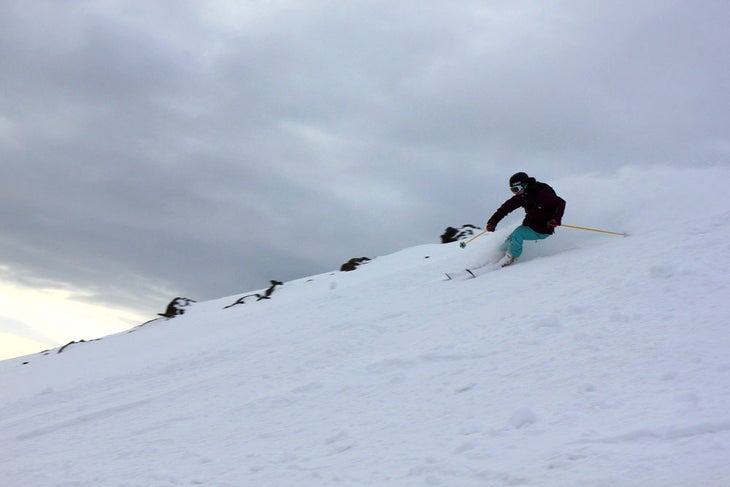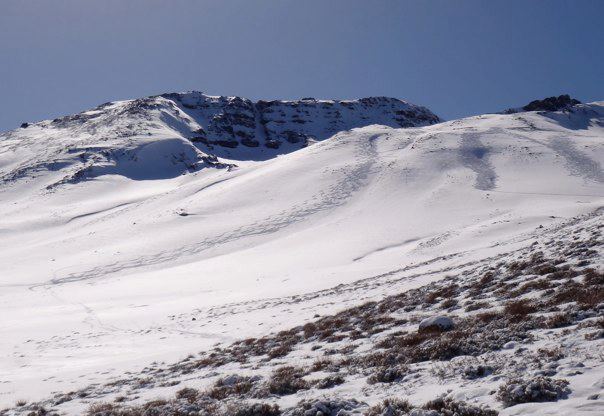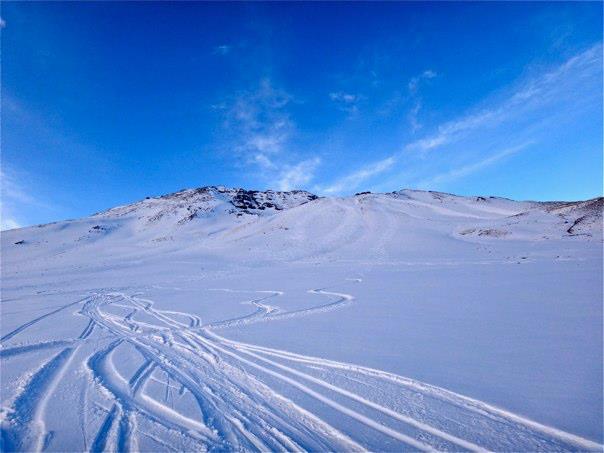Heading out the door? Read this article on the new Outside+ app available now on iOS devices for members! Download the app.
Our editor recently chased winter and one of the world’s best skiers 14 hours south of the equator to La Parva, Chile. Five days skiing off-piste with big-mountain sage Ingrid Backstrom is awfully enlightening. Here’s what she learned.
(Click here to read her Day 1 dispatch)
Our second day starts with a quick morning yoga and stretching session in La Parva’s gym. Floor-to-ceiling glass windows overlook the valley below, and we can see Santiago under a sheath of clouds and smog. Heidi and Amanda, the other two women participating in the camp arrived late last night and have opted to sleep in, as did Lila and Suzanna. It’s just Phil, Ingrid and myself. I follow Ingrid’s lead through a series of core strength exercises, which she does effortlessly. I fumble and flail through two sets of side-plank twists that will make walking, laughing and turning over in bed—not to mention turning my skis and poling across the flats— painful for the next three days. Propped up on elbows and toes, my midsection quaking, I look over at Ingrid and notice her well-defined arms and her perfectly straight plank position from head to heels. She is strong and stable, and the time she spends in the gym—even if it’s just a half-hour a day when she’s traveling—is one of the factors that contribute to her agility on the hill. I knew keeping up with her would be a challenge, but I didn’t expect her to kick my butt before we even got on the mountain. Still the 30-minute workout, humbling as it is, wakes up my legs and core, and I’m grateful I pulled myself out of bed for the morning workout.

The other women join us for a Chilean breakfast of eggs, bread, corn flakes, fruit, cheese and café con leche at St. Tropez, the quaint chalet-style restaurant at the base of La Parva’s lifts. Before booting up, Ingrid does an informal introduction and goes over our plan for the week. This camp is designed to introduce us to off-piste and backcountry skiing tactics. We’ll learn how to look at the terrain, evaluate the conditions and travel safely outside of the resort in untracked and variable snow. But before we get ahead of ourselves, Ingrid says, we need to work on some fundamentals. I couldn’t agree more. I haven’t been in ski boots for nearly five months, and I feel rusty.
We get dressed, grab the Poma and cruise up the mountain, which we can see clearly today under a glistening blue sky and strong South American sunshine. Ingrid and Phil lead us to the far end of the resort, where we find a short, steepish pitch to practice our “power positions”—hands in front of us, arms loose, shoulders and eyes pointed down the fall line. Here, Ingrid demonstrates what she means and then puts us through a quick drill that helps us “feel the power.”
from SKI Magazine on Vimeo.
For the rest of the week, Ingrid will remind us of our power positions, which, as she says, are the secret to maintaining control in all terrain types and conditions. We make a couple runs on this same pitch to get the feel for what she’s talking about, and then it’s time to explore off-piste, in-bounds first, then beyond the resort line.
A lack of significant snowfall the weeks before we arrived and a fair amount of wind the past several days have painted the slopes with patches of sastrugi, but that just gives Phil and Ingrid plenty of teaching material. We’ll stop on the top of runs or on the side of the trails to look at and talk about the clues available to help us predict snow conditions and potential hazards. Phil, who is not only a PowderQuest ski guide but also an avalanche forecaster with encyclopedic knowledge of weather systems and snow safety, explains how the cloud patterns, the location of the sun, and wind direction affect snow on different aspects of the slope.
“My guess,” he says, pointing to the far side of a ridge we’ve scoped out, “is that the snow will be deepest and softest over there. Stay high, make a little slash turn on that wind wave if you want, then point ‘em straight fall line to the road.” I follow his directions to a T, whooping all the way as my skis slice through smooth, dry snow. “Good guess,” I think to myself when I reach the road.

After a leisurely lunch on the sunny BBB deck, we head up the lift and to the far skier’s right of the resort. We blow past a pair of wind fences and leave the groomed piste behind. We’re all shocked at what we find. The three or four bowls off the resort’s flanks are relatively soft and forgiving and completely untouched. If this were the U.S., we all marvel, this area would have been chewed up and spit out days— if not weeks—ago. No doubt La Parva’s officials are wringing their hands about the recent drought, but we couldn’t be less concerned. We’ve hit a jackpot that will continue paying out for the rest of the week. We know there are a few rocks just under the surface, but thanks to the bright sunlight, their shark fins are easy to spot and avoid. Plus, this is a big mountain freeride camp; it’s exactly what we came here to experience. If I didn’t know better, I’d think Ingrid planned this.

She drops in first and carves a perfect series of Ss down the long slope. We follow, one by one, spooning each other’s tracks and making sure to leave plenty of fresh snow—and plenty of anticipation—for our next visit.